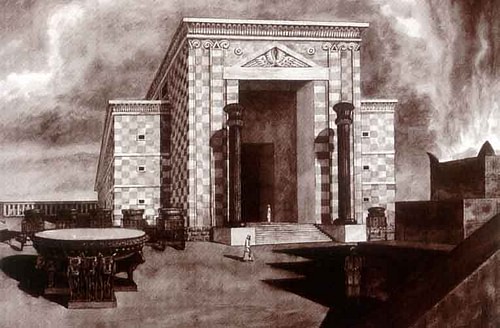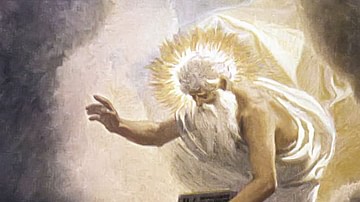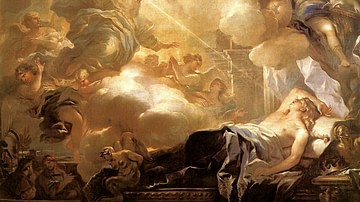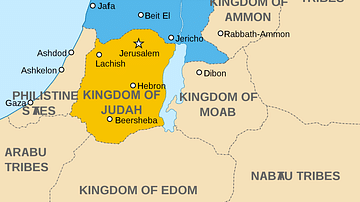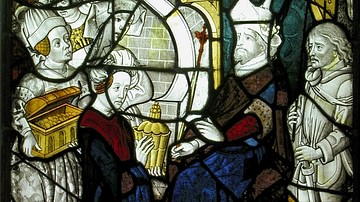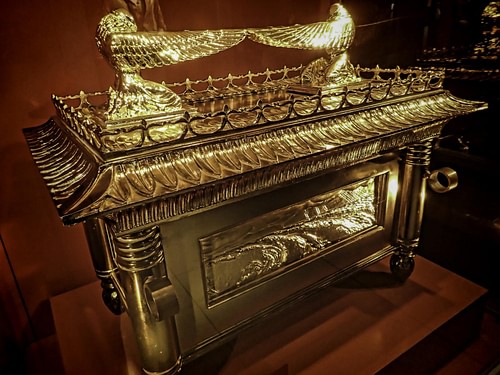
The Ark of the Covenant refers to the box-like container that held the tablets of the Law received by Moses on Mount Sinai. Tradition claimed that it contained two stone tablets, carved by God, listing the first ten commandments given to Israel. The receipt of the tablets and the details of the construction of the Ark appear in the book of Exodus.
After the Israelites escaped from Egypt, Moses led them to the mountain in Sinai where he had his first revelation from God. He left the people in the camp and was on the mountain for forty days and nights. What Moses received was not just the traditional idea of ten commandments but literally what would become the constitution for the nation of Israel.
By Jewish traditions, Moses received a great deal of information while he was on the mountain. Many of the details are contained in the books of Exodus, Leviticus (the priests' manual), Numbers (the time of the Hebrew wanderings in the wilderness), and Deuteronomy (a second source for the original legislation). Later editors claimed that he received the blueprints for building Solomon’s Temple in Jerusalem (c. 900 BCE).
Over time, the commandments became reduced to ten words, with the Hebrew rendering in short statements: "Do not lie," "Do not steal." In the Greek translation of the Jewish Scriptures, the Septuagint, they were dubbed the Decalogue. In terms of theology, the tablets were understood to be divided: the first five are elements related to the worship of the God of Israel, and the rest are related to human behavior as a nation. Modern iconography of the tablets retains both the Hebrew letters and the later adoption of Roman numerals.
The Ark
The term 'ark' comes from the Latin arca ("chest"). The Hebrew tevah most likely derived from the Babylonian word for boat. The Babylonians had an earlier story of a flood in the Epic of Gilgamesh, where the ark was a boat like Noah’s. The term 'ark' was imbued with theological significance, with the same word used for Noah’s ship, the basket that was floated down the Nile with the infant Moses, and the box that eventually held the commandments. These three became understood as vessels of salvation.
The instructions for the creation of the Ark were included in the paraphernalia of what would become the 'tabernacle' or 'tent of meeting':
Then have them make a sanctuary for me, and I will dwell among them ... Have them make an Ark of acacia wood—two and a half cubits long, a cubit and a half wide, and a cubit and a half high [approximately 131×79×79 cm or 52×31×31 in]. Overlay it with pure gold, both inside and out, and make a gold molding around it. Cast four gold rings for it and fasten them to its four feet, with two rings on one side and two rings on the other. Then make poles of acacia wood and overlay them with gold. Insert the poles into the rings on the sides of the ark to carry it ... Then put in the ark the tablets of the covenant law, which I will give you. Make an atonement cover of pure gold—two and a half cubits long and a cubit and a half wide. And make two cherubim out of hammered gold at the ends of the cover. The cherubim are to have their wings spread upward, overshadowing the cover with them. The cherubim are to face each other. Place the cover on top of the ark and put in the ark the tablets of the covenant law that I will give you. There, above the cover between the two cherubim that are over the ark of the covenant law, I will meet with you and give you all my commands for the Israelites. (Exodus 25).
The "atonement cover" of cloth was later depicted as the mercy seat of God. These details have become iconic in illustrations of the Ark. For many historians, the precise detail in Exodus implies the reality of the Ark. Subsequent references to the Ark in the Jewish Scriptures have the same details.
The Ark in the Wilderness
The 'tent of meeting' served as a portable shrine during the years in the wilderness. Inside the tent, at the center, was the Ark of the Covenant, and then zones of sacredness; priests, men, women in relation to sacred space. Only Moses and Aaron were permitted to enter the presence of the Ark. The first duty upon setting up a new camp was to erect the shrine, and it was the last thing taken down when they moved on. Those carrying the equipment were placed in the center of the migrations for protection as they moved. The Ark was always carried by the tribe of Levities, the descendants of Moses and Aaron.

Numbers 9:15 described the tabernacle of the Ark being covered in a cloud by day and fire at night, demonstrating God’s presence among them.
Whenever they set out, Moses would say: "Rise up, Lord! May your enemies be scattered; may your foes flee before you." Whenever it came to rest, he said, "Return, Lord, to the countless thousands of Israel." (Numbers 10:35-36)
Thus, the ancient tradition that the Ark held power to defeat Israel’s enemies. This was the premise in the blockbuster movie, Indiana Jones and Raiders of the Lost Ark.
The next several books of the Jewish Scriptures relate the stories of the Israelites settling in the land of Canaan and establishing a united monarchy. With the deaths of Moses and Aaron in the wilderness, it was up to Joshua (Moses’ lieutenant) to bring the tribes into the land. Coming from the East, Joshua led the priests across the Jordan river carrying the Ark. The waters parted, in a replication of the crossing of the Red Sea. Attacking Jericho, the Ark was carried in circumnavigations around the city walls, until "the walls came crashing down" (Hebrews 11:30). Once settled in the land, Joshua read the Law to the people standing on either side of the Ark at Mount Gerizim.
The Capture of the Ark by the Philistines
The book of Judges relates the time when Canaan was ruled by a confederation of the Twelve Tribes. To avoid tribal dominance and jealousy, the 'tent of meeting' was erected in tribal lands in rotation for specific periods of time. The invasion of the Philistines at the end of the Bronze Age (the Sea Peoples in other ancient texts) resulted in several defeats for the Israelites. 1 Samuel 4 related the decision by the priests of Shiloh (where the Ark was temporarily housed), to take the Ark into battle as insurance against the enemy. To great dismay, the Ark was captured by the Philistines and set up in their temple to Dagon (their chief god) at Ashdod.
What followed was a list of problems for the Philistines. Each morning the statue of Dagon was found on the ground before the Ark. The Philistines were punished with tumors and boils (most likely bubonic plague), and a scourge of mice destroyed their grain. They put the Ark on a cart and sent it back to the Israelites. It remained in the town of Keriath-Jearim (Abu Gosh) for the next 20 years.
Solomon's Temple & Babylonian Invasion
David (c. 1000 BCE) arose as a king over the other tribes in what became known as “the united monarchy.” He conquered Jerusalem (the city of the Jebusite tribes) and made it the capital. David had plans to build a permanent house for God (a stone temple) and ordered the Ark to be brought to the city. When the cart teetered along the way, one of the drivers reached up to stop its falling and was struck dead. David then had the Ark carried into the city by the Levites. David was not able to build the temple because he was a sinner, but his son Solomon accomplished this feat. The Ark of the Covenant was placed in the very center of Solomon's Temple, in the "holy of holies". Only the high priest could enter the "holy of holies" on Yom Kippur.
Yom Kippur became an annual ritual, the Day of Atonement (Leviticus 16). The high priest sacrificed two goats who symbolically carried the sins of the people. One was sent to the wilderness (the origin of "scapegoat") and the other sacrificed on the altar. The blood was sprinkled on the mercy seat of the Ark of the Covenant.
After the death of Solomon, 1 Kings 14:25 recounts the story of Pharaoh Shishak of Egypt who conquered the region and sacked Jerusalem. Shishak has been identified as Shoshenq I of the 22nd Dynasty of Egypt (10th century BCE): "Shishak took away treasures of the Temple of Yahweh and the king's house, as well as shields of gold which Solomon had made." Scholars debate if the spoils included the Ark.
The Ark next appears in 2 Chronicles 35:1-6, when King Josiah (640-609 BCE), a religious reformer, orders the Levities to "put the sacred Ark in the temple that Solomon son of king David built." For some theorists, this assumes that it was hidden during Shishak’s invasion where it remained until the reign of Josiah.
In 587 BCE, the city of Jerusalem and Solomon’s Temple were destroyed by the Babylonians. The later apocryphal text of 1 Esdras said they took the "vessels of the Ark of God", and the king’s treasures along with captives to Babylon but does not specify the Ark itself. The Jewish Scriptures which narrate the stories of life in Babylon and in Persia, make no mention of the Ark. It is from this moment in the chronology of the history of Israel that scholars, archaeologists, and amateurs have been searching for the Ark of the Covenant in the last two centuries. Competing with the Holy Grail, the Ark remains one of the most coveted relics of ancient times. Theories concerning the Ark find elements culled from Jewish Hellenistic literature.
The books of the Maccabees recount the successful Jewish revolt against Greek rule under Antiochus Epiphanes in 167 BCE. This second book claimed that during the Babylonian invasion, the Prophet Jeremiah hid the sacred fire of the Temple, as well as the Ark:
The records show that it was the prophet Jeremiah who ... prompted by a divine message ... gave orders that the Tent of Meeting and the ark should go with him. Then he went away to the mountain from the top of which Moses saw God's promised land [Mt. Nebo]. When he reached the mountain, Jeremiah found a cave-dwelling; he carried the tent, the ark, and the incense-altar into it, then blocked up the entrance. Some of his companions came to mark out the way but were unable to find it. When Jeremiah learnt of this he reprimanded them. "The place shall remain unknown," he said, "until God finally gathers his people together and shows mercy to them. The Lord will bring these things to light again, and the glory of the Lord will appear with the cloud, as it was seen both in the time of Moses and when Solomon prayed that the shrine might be worthily consecrated." (2 Maccabees 4-10)
Mount Nebo remains a popular place for illegal excavations, although the government of Jordan attempts to monitor these activities.
Josephus & the Ark of the Covenant
Flavius Josephus (36-100 CE) was a Jewish historian who described Pompey's (106-48 BCE) siege of Jerusalem of 63 BCE:
But there was nothing that affected the nation so much, in the calamities they were then under, as that their holy place, which had been hitherto seen by none, should be laid open to strangers; for Pompey, and those that were about him, went into the temple itself, whither it was not lawful for any to enter but the high priest, and saw what was deposited there, the candlestick with its lamps, and the table, and the pouring vessels, and the censers, all made entirely of gold, as also a great quantity of spices heaped together, with two thousand talents of sacred money. (The Wars of the Jews, 1. 7. 6.)
The most notable omission in the list is the Ark of the Covenant. Josephus was also a witness to the destruction of Jerusalem and the Temple complex by the Roman Empire in the year 70 CE, in the war following the Great Jewish Revolt of 66 CE. In a more ambiguous description of Roman emperor Titus’ (r. 79-81) Roman triumph, Josephus listed the loot:
But for those that were taken in the temple of Jerusalem, they made the greatest figure of them all; that is, the golden table, of the weight of many talents; the candlestick also, that was made of gold . . . and the last of all in the spoils, was carried the law of the Jews" (Wars, Book 7:147-151).
Titus’ triumphal arch stands today in the Roman Forum. The candlestick (menorah) is notable, but nothing that resembles the Ark. The phrase "the law of the Jews", however, contributed to later (and ongoing) theories that the Ark remains hidden in Rome.

Where is the Ark of the Covenant?
Among the scrolls of the Essenes discovered at Qumran is a unique item known as the Copper Scroll. In this scroll, the letters were hammered into sheets of copper. The Scroll lists 64 places where gold and silver were hidden. Like the other scrolls, the descriptions of the places and the contents are sometimes in coded language, so that the specific sites are difficult to unravel. Some theories claim that the Ark was hidden during the siege of Rome in the Jewish Revolt, and the Copper Scroll offers a clue.
The Ark is only mentioned twice in the New Testament. The Letter to the Hebrews (variously dated in the 80s or 90s CE) argues that Christ is the true high priest, with descriptions of a heavenly temple which include the Ark. In the visions of John of Patmos in the Book of Revelation, he saw the Temple in heaven "and the Ark of his covenant was seen within his Temple" (11:19).
Baruch is an apocalyptic text of the late 1st century CE written after the destruction of the Temple. It relates the story of angels descending before the siege to save the Temple implements until the time of "restoration." The earth was ordered to "swallow them up" (6:7).
In addition to searching Mount Nebo and Rome, the Ark has been sought in other places. The Knights Templar, European knights dedicated to the Church, were organized during the Crusades to act as body guards for pilgrims to the Holy Land. There are stories that while camped on the Temple Mount in Jerusalem, they discovered treasures which included both the Holy Grail as well as the Ark of the Covenant. When the Knights were banned and executed in 1307, rumors of their survival and their treasures have multiplied over the centuries. A popular theory is that their treasures were stored at Rennes-le-Château in southern France. From there to Scotland, and then to the United States, on the theory that the Templars became the Masonic Order.
The Ethiopian Orthodox Tewahedo Church remains one of the more famous claims, declaring that the Ark is housed in the Church of Our Lady Mary of Zion in the city of Axum. The story of the Ark’s journey from Jerusalem to Ethiopia is contained in their sacred text, the Kebra Nagast. Menelik I (10th century BCE) was the founder of the Ethiopian Empire. According to the claim, he was the son of Solomon and the Queen of Sheba who had visited Jerusalem. Raised as a Jew, Menelik visited the capital, and in a vision (of impending destruction), took the real Ark and left a replica.
Ethiopia did have a large community of Jews, the remnants of which were airlifted to Israel during Operation Solomon in 1991. During the Middle Ages, however, the country was converted to the Orthodox Church. But the Ethiopian Church adopted the traditions; every church has a tabot (a box) that resembles the Ark. There is a yearly festival where the priests march in procession with tabots on their heads. One priest is selected to spend the rest of his life as a guardian at the church in Axum. All efforts to see the Ark have been strenuously denied.
The Temple Mount & Synagogues Today
The original site of the Temple complex sits on bedrock, with many tunnels dug into the rock. However, the Temple Mount (with the shrine of the Dome of the Rock) was placed in charge of the Mufti (the Muslim authority) during the last days of the British mandate in 1948. The Muslim authorities forbid any archaeological excavation in and around the Temple Mount in Jerusalem. While digging a tunnel in 1981 from the Western Wall under the Muslim Quarter, a doorway into the complex was discovered. When this was leaked to the press, all excavations were halted. The Temple Mount remains one of the most sensitive areas for both Jews and Muslims.
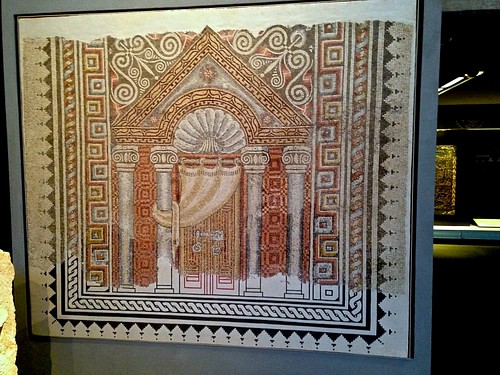
Synagogues have a special niche or place for a symbolic Ark of the Covenant. This is where the Torah scrolls are kept which contain the teachings of Moses and the Prophets. Outside of Israel, the Ark faces Jerusalem. In Israel itself, Yom HaAliyah (Aliyah Day, or "going up" as in going up to Jerusalem), is a national holiday that celebrates Joshua’s crossing of the Jordan River while carrying the Ark of the Covenant.

